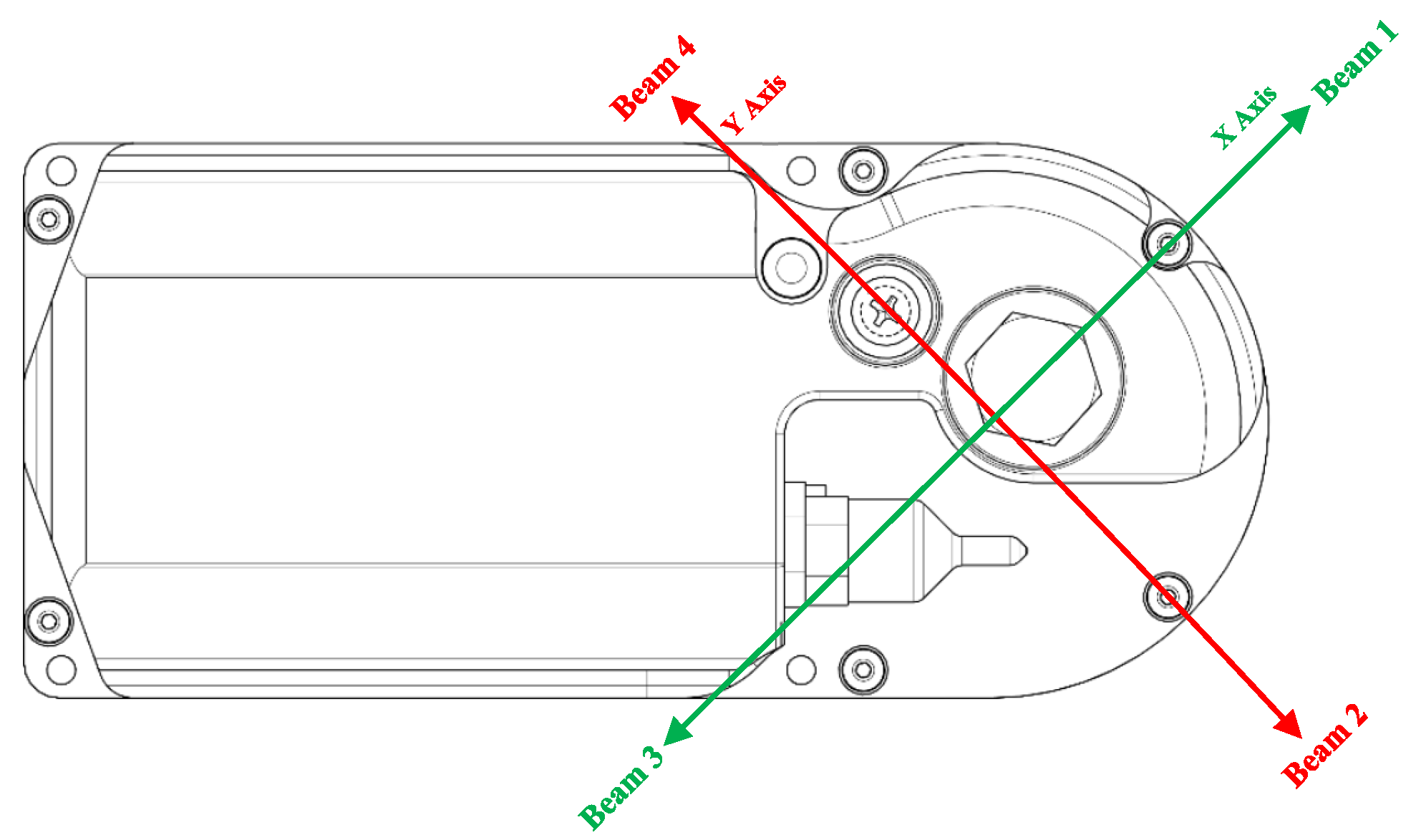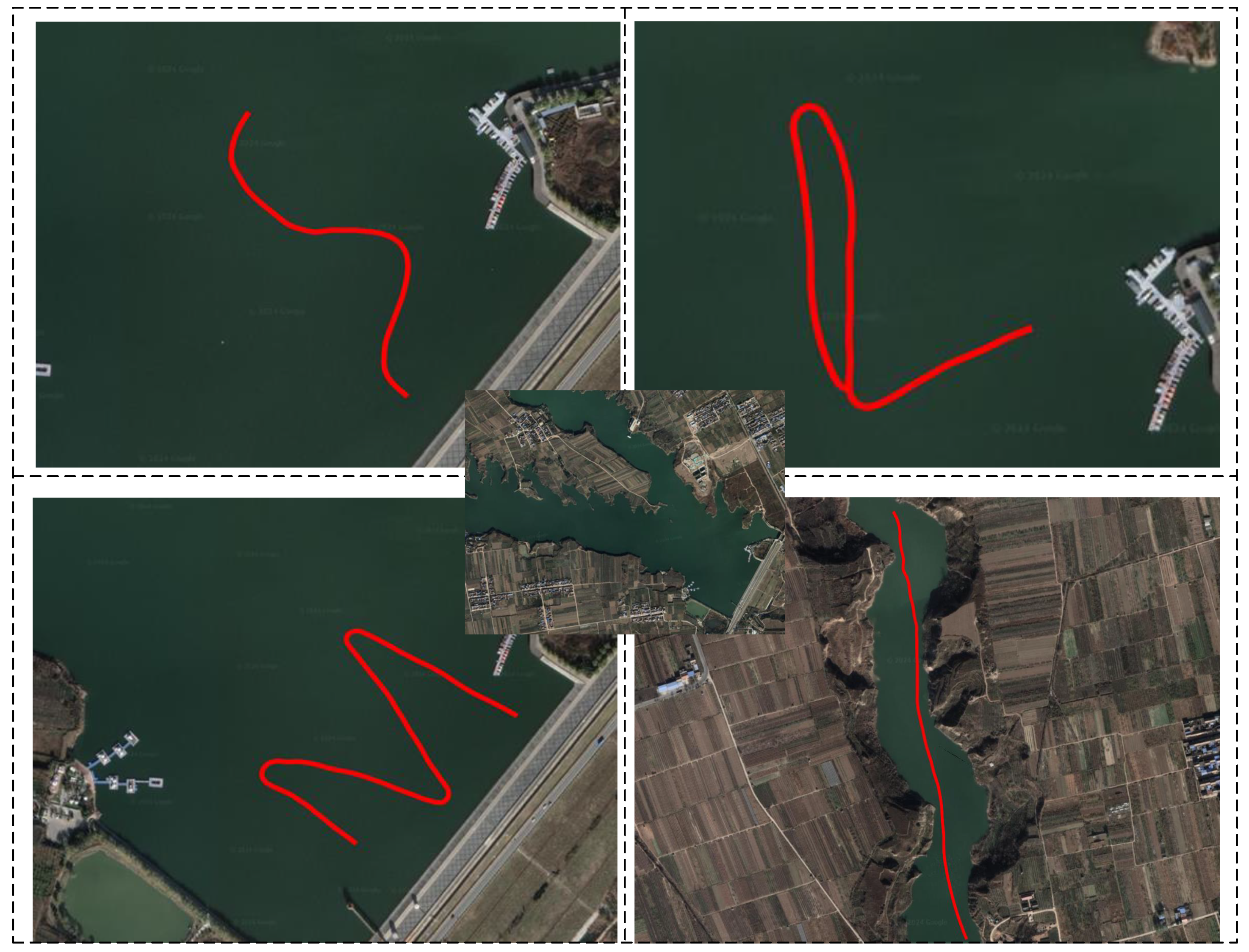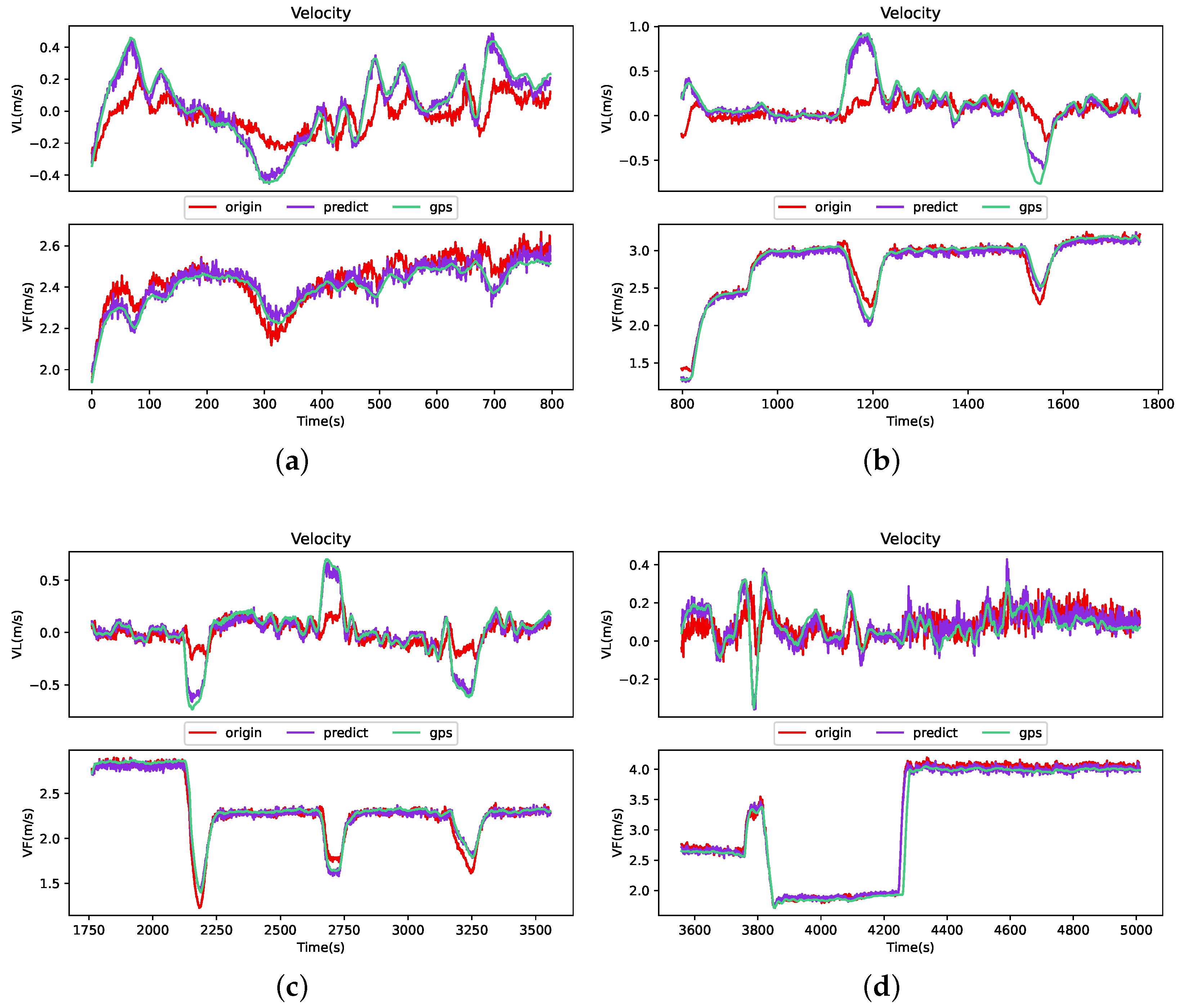Underwater DVL Optimization Network (UDON): A Learning-Based DVL Velocity Optimizing Method for Underwater Navigation
Abstract
1. Introduction
- We propose a deep-learning-based method for improving DVL measurements. This approach can compensate for external interferences during the DVL speed measurement process, therefore enhancing the accuracy of the DVL velocity vector.
- To facilitate further research in this field, we plan to make the test dataset and related code files publicly available and store them in a GitHub repository for everyone’s use. (https://github.com/Graceful-ZSP/DVL-Improved.git) (accessed on 29 December 2024)
2. Principles and Network Framework
2.1. DVL Velocity Calculation
2.2. Deep-Learning Network Framework Based on IMU/DVL Integration
- Flatten Layer: Transforms multi-dimensional input data into a one-dimensional format.
- Dropout Layer: Regularizes the input data to reduce the risk of model overfitting.
- Linear Layer: Performs a linear transformation on the input data, integrating features and producing an output of a fixed size.
- Tanh Activation Function: The hyperbolic tangent function maps the input value x to a nonlinear range between −1 and 1. It is specifically implemented as:
- ReLU (Rectified Linear Unit) Activation Function: Also known as the ramp function, it is a nonlinear function with both biological and mathematical foundations, and it is specifically implemented as:
- 1D Conv Layer: Creates a convolutional kernel that captures local features of the input data along a single spatial dimension through convolution and outputs a feature vector. In a 1D Conv layer, all input parameters interact directly with the output. The relationship between the input and output is as follows:where x is input, y is output, t represents the timestamp, p denotes the kernel length. The p is the size of the filter or kernel used in the convolutional operation. The w symbolizes the learned weights.
- LSTM Layer: The LSTM layer can learn the long-term dependencies in the input data and extract the temporal features of the data through its internal gating structure. It is an advanced version of the Recurrent Neural Network (RNN) because it solves the problem of gradient explosion in time series [38]. The LSTM uses input gates, output gates, and forget gates to extract temporal features. The role of the forget gate is to discard irrelevant information from previous outputs and current inputs, represented as:where is the current input, is the output from the previous moment, and are the forget gate weights, and is the bias. The role of the input gate is to update the cell state, represented as:where and are the input gate weights, and is the bias. The role of the output gate is to determine the output and decide which information from the cell state to pass on, represented as:where and are the input gate weights, and is the bias. The LSTM layer outputs the current output and hidden state, represented as the result of the output gate multiplied by the cell state through a tanh layer:where is the current cell state, represented as Equation (18).where is the estimated cell state, represented as Equation (19)where and are the gate weights, and is the bias.
2.3. Network Hyperparameter Definition
3. Data Acquisition System Composition
3.1. Hardware Equipment
3.2. Data Collection Methods
4. Data Analysis
- Root Mean Squared Error (RMSE), a metric used to measure the difference between the model’s predictions and the actual values. The smaller the metric, the smaller the difference between the model’s predictions and the actual values, indicating better model prediction performance:where refers to the true value at time i, and refers to the predicted value at time i.
- Mean Absolute Error (MAE), a metric used to measure the prediction error of the model. The smaller the metric, the smaller the prediction error, indicating better model prediction performance:
- Coefficient of Determination (), which indicates the strength of the relationship between two quantities. The closer the metric is to 1, the stronger the relationship between the two quantities, and the closer to 0, the weaker the relationship:where represents the mean of the true values.
- Variance Accounted For (VAF), a metric used to evaluate the predictive capability of the model. The larger the metric, the better the model’s predictive ability:
5. Conclusions and Prospects
5.1. Conclusions
5.2. Prospects
- Transferability between different DVL: Different DVL products are bound to affect the transferability of the model. In the future, the robustness of the model can be enhanced to achieve compatibility with different models of DVL products.
- Transferability between different installation settings: When installing DVL and SINS, it is necessary to pay attention to the compensation of the lever arm and perform navigation after the SINS alignment, which can improve the stability of the equipment.
- Transferability between SINS changes: Different SINS will also affect performance, but the better the performance of the SINS, the greater the improvement effect on the DVL. In the future, the performance of the model can be indirectly improved by improving the performance of the SINS.
Author Contributions
Funding
Institutional Review Board Statement
Informed Consent Statement
Data Availability Statement
Acknowledgments
Conflicts of Interest
Abbreviations
| AUV | Autonomous Underwater Vehicle |
| SINS | Strapdown Inertial Navigation System |
| DVL | Doppler Velocity Log |
| GPS | Global Positioning System |
| CNN | Convolutional Neural Network |
| LSTM | Long Short-Term Memory |
| GNSS | Global Navigation Satellite System |
| MBES | Multibeam echo sounder |
| KF | Kalman Filter |
| AI | artificial intelligence |
| LS | Least Squares |
| GRU | Gated Recurrent Unit |
| 1D Conv | one-dimensional convolutional |
| ReLU | Rectified Linear Unit |
| RNN | Recurrent Neural Network |
| MSE | Mean Squared Error |
| RMSE | Root Mean Squared Error |
| MAE | Mean Absolute Error |
| Coefficient of Determination | |
| VAF | Variance Accounted For |
| ATE | Absolute Trajectory Error |
| RTE | Relative Trajectory Error |
References
- Paull, L.; Saeedi, S.; Seto, M.; Li, H. AUV navigation and localization: A review. IEEE J. Ocean. Eng. 2013, 39, 131–149. [Google Scholar] [CrossRef]
- Wynn, R.; Huvenne, V.; Le Bas, T.; Murton, B.J.; Connelly, D.P.; Bett, B.J.; Ruhl, H.A.; Morris, K.J.; Sumner, E.J.; Darby, S.E.; et al. Autonomous Underwater Vehicles (AUVs): Their past, present and future contributions to the advancement of marine geoscience. Mar. G Eology 2014, 352, 451–468. [Google Scholar] [CrossRef]
- Zhang, B.; Ji, D.; Liu, S.; Zhu, X.; Xu, W. Autonomous underwater vehicle navigation: A review. Ocean Eng. 2023, 273, 113861. [Google Scholar] [CrossRef]
- Mu, X.; He, B.; Wu, S.; Zhang, X.; Song, Y.; Yan, T. A practical INS/GPS/DVL/PS integrated navigation algorithm and its application on Autonomous Underwater Vehicle. Appl. Ocean Res. 2021, 106, 102441. [Google Scholar] [CrossRef]
- Ding, S.; Ma, T.; Li, Y.; Xu, S.; Yang, Z. RD-VIO: Relative-depth-aided visual-inertial odometry for autonomous underwater vehicles. Appl. Ocean Res. 2023, 134, 103532. [Google Scholar] [CrossRef]
- Miller, A.; Miller, B.; Miller, G. AUV position estimation via acoustic seabed profile measurements. In Proceedings of the 2018 IEEE/OES Autonomous Underwater Vehicle Workshop (AUV), Porto, Portugal, 6–9 November 2018. [Google Scholar]
- Luo, L.; Zhang, Y.; Fang, T.; Li, N. A new robust Kalman filter for SINS/DVL integrated navigation system. IEEE Access 2019, 7, 51386–51395. [Google Scholar] [CrossRef]
- Wang, D.; Xu, X.; Huo, L. An improved adaptive Kalman filter for underwater SINS/DVL system. Math. Probl. Eng. 2020, 2020, 5456961. [Google Scholar] [CrossRef]
- Liu, R.; Liu, F.; Liu, C.; Zhang, P. Modified Sage-Husa Adaptive Kalman Filter-Based SINS/DVL Integrated Navigation System for AUV. J. Sens. 2021, 2021, 9992041. [Google Scholar] [CrossRef]
- Xu, B.; Guo, Y.; Hu, J.; Zhang, P. An improved robust Kalman filter for SINS/DVL tightly integrated navigation system. IEEE Trans. Instrum. Meas. 2021, 70, 8502915. [Google Scholar] [CrossRef]
- Dang, L.; Chen, B.; Huang, Y.; Zhang, Y.; Zhao, H. Cubature Kalman filter under minimum error entropy with fiducial points for INS/GPS Integration. IEEE/CAA J. Autom. Sin. 2022, 9, 450–465. [Google Scholar] [CrossRef]
- Melo, J.; Matos, A.; Liu, S.; Zhu, X. Survey on advances on terrain based navigation for autonomous underwater vehicles. Ocean Eng. 2017, 139, 250–264. [Google Scholar] [CrossRef]
- Miller, P.; Farrell, J.; Zhao, Y.; Djapic, V. Autonomous underwater vehicle navigation. IEEE J. Ocean. Eng. 2010, 35, 663–678. [Google Scholar] [CrossRef]
- Gao, X.; Lv, Y. The technique of installation error angle calibration in the experiment of accuracy evaluation in INS. In Proceedings of the 2017 IEEE 3rd Information Technology and Mechatronics Engineering Conference (ITOEC), Chongqing, China, 3–5 October 2017. [Google Scholar]
- Liu, X.; Zheng, J.; Lu, J.; Zhao, V.; Ye, L. Reducing the Effect of the Accelerometer-Slope Bias Error on the Calibration Error of a High-Precision RLG INS System-Level Fitting Method. IEEE Trans. Instrum. Meas. 2021, 70, 9511009. [Google Scholar] [CrossRef]
- Lu, J.; Ye, L.; Niu, Z.; Dong, J.; Su, A. An all-parameter calibration for 6-axis skewed IMU. IEEE Trans. Ind. Electron. 2023, 70, 3126–3135. [Google Scholar] [CrossRef]
- Pan, J.; Li, B.; Zhang, H.; Gao, F.; Li, X.; Zhou, G. Self-Calibration of INS/Odometer Integrated Navigation System With a Large Initial Position Error. IEEE Sens. J. 2024, 24, 11048–11056. [Google Scholar] [CrossRef]
- Cheng, J.; Liu, J.; Cai, J.; Xu, Y. A Polar Integrated Alignment Assisted by DVL Under Large Azimuth Misalignment. IEEE Sens. J. 2023, 23, 5962–5973. [Google Scholar] [CrossRef]
- Wang, Q.; Liu, K.; Cao, Z. System noise variance matrix adaptive Kalman filter method for AUV INS/DVL navigation system. Ocean Eng. 2023, 267, 113269. [Google Scholar] [CrossRef]
- Liu, C.; Wang, J.; Cao, J. Multi-resolution Noise Reduction Models for Denoising INS Raw Data. Energy Procedia 2011, 13, 6677–6683. [Google Scholar]
- Zhi, Z.; Liu, D.; Liu, L. A performance compensation method for GPS/INS integrated navigation system based on CNN-LSTM during GPS outages. Measurement 2022, 188, 110516. [Google Scholar] [CrossRef]
- Abdolkarimi, E.; Mosavi, M. A modified neuro-fuzzy system for accuracy improvement of low-cost MEMS-Based INS/GPS navigation system. Wirel. Pers. Commun. 2023, 192, 1369–1392. [Google Scholar] [CrossRef]
- Wang, D.; Xu, X.; Yang, Y.; Zhang, T. A quasi-Newton quaternions calibration method for DVL error aided GNSS. IEEE Trans. Veh. Technol. 2021, 70, 2465–2477. [Google Scholar] [CrossRef]
- Lv, P.; He, B.; Guo, J.; Shen, Y.; Yan, T.; Sha, Q. Underwater navigation methodology based on intelligent velocity model for standard AUV. Ocean Eng. 2020, 202, 107073. [Google Scholar] [CrossRef]
- Yao, Y.; Xu, X.; Hou, L.; Deng, K.; Xu, X. A simple and precise correction method for DVL measurements under the dynamic environment. IEEE Trans. Veh. Technol. 2020, 69, 10750–10758. [Google Scholar] [CrossRef]
- Xu, B.; Guo, Y. A novel DVL calibration method based on robust invariant extended Kalman filter. IEEE Trans. Veh. Technol. 2022, 71, 9422–9434. [Google Scholar] [CrossRef]
- Zhao, L.; Liu, X.; Wang, L.; Zhu, Y.; Liu, X. A pretreatment method for the velocity of DVL based on the motion constraint for the integrated SINS/DVL. Appl. Sci. 2016, 6, 79. [Google Scholar] [CrossRef]
- Ansari-Rad, S.; Hashemi, M.; Salarieh, H. Pseudo DVL reconstruction by an evolutionary TS-fuzzy algorithm for ocean vehicles. Measurement 2019, 147, 106831. [Google Scholar] [CrossRef]
- Yona, M.; Klein, I. MissBeamNet: Learning missing Doppler velocity log beam measurements. Neural Comput. Appl. 2024, 36, 4947–4958. [Google Scholar] [CrossRef]
- Klein, I.; Lipman, Y. Continuous INS/DVL fusion in situations of DVL outages. In Proceedings of the 2020 IEEE/OES Autonomous Underwater Vehicles Symposium (AUV), Newfoundland and Labrador, St. John’s, NL, Canada, 30 September–2 October 2020. [Google Scholar]
- Kinsey, J.; Whitcomb, L. In situ alignment calibration of attitude and Doppler sensors for precision underwater vehicle navigation: Theory and experiment. IEEE J. Ocean. Eng. 2007, 32, 286–299. [Google Scholar] [CrossRef]
- Wang, G.; Xu, X.; Yao, Y. An iterative Doppler velocity log error calibration algorithm based on newton optimization. Math. Probl. Eng. 2020, 2020, 3194034. [Google Scholar]
- Li, D.; Xu, J.; Zhu, B.; He, H. A calibration method of DVL in integrated navigation system based on particle swarm optimizatio. Measurement 2022, 187, 110325. [Google Scholar] [CrossRef]
- Cohen, N.; Klein, I. BeamsNet: A data-driven approach enhancing Doppler velocity log measurements for autonomous underwater vehicle navigation. Eng. Appl. Artif. Intell. 2022, 114, 105216. [Google Scholar] [CrossRef]
- Braginsky, B.; Baruch, A.; Guterman, H. Correction of DVL error caused by seafloor gradient. IEEE Sens. J. 2022, 20, 11652–11659. [Google Scholar] [CrossRef]
- Tal, A.; Klein, I.; Katz, R. Inertial navigation system/doppler velocity log (INS/DVL) fusion with partial DVL measurements. Sensors 2017, 17, 415. [Google Scholar] [CrossRef] [PubMed]
- Liu, Y.; Luo, Q.; Zhou, Y. Deep Learning-Enabled Fusion to Bridge GPS Outages for INS/GPS Integrated Navigation. IEEE Sens. J. 2022, 22, 8974–8985. [Google Scholar] [CrossRef]
- Pascanu, R.; Mikolov, T.; Bengio, Y. On the difficulty of training recurrent neural networks. In Proceedings of the 30th International Conference on Machine Learning: ICML 2013, Atlanta, GA, USA, 16–21 June 2013. [Google Scholar]
- Armaghani, D.; Asteris, P. A comparative study of ANN and ANFIS models for the prediction of cement-based mortar materials compressive strength. Neural Comput. Appl. 2021, 33, 4501–4532. [Google Scholar] [CrossRef]








| Device | Parameter | Performance | Coordinate System |
|---|---|---|---|
| SINS | Heading accuracy | 0.05° | Forward, left, up |
| Gyro zero deviation stability | ≤0.1°/h | ||
| Accelerometer zero offset stability | ≤20 g | ||
| DVL | Frequency | 614.4 kHz | Forward, left, up |
| Velocity accuracy | ±0.2% ±0.2 cm/s | ||
| Altitude | 0.2 m–89 m |
| Indicators | Code Name | DVL | Proposed | Improvement |
|---|---|---|---|---|
| RMSE | Task-1 | 0.1132 | 0.0348 | 69.26% |
| Task-2 | 0.1596 | 0.0524 | 67.17% | |
| Task-3 | 0.1242 | 0.0390 | 68.60% | |
| Task-4 | 0.1271 | 0.0974 | 23.37% | |
| MAE | Task-1 | 0.0919 | 0.0284 | 69.10% |
| Task-2 | 0.0959 | 0.0396 | 58.71% | |
| Task-3 | 0.0763 | 0.0308 | 59.63% | |
| Task-4 | 0.0663 | 0.0432 | 34.84% | |
| Task-1 | 0.5077 | 0.9341 | 83.99% | |
| Task-2 | 0.5751 | 0.9704 | 68.74% | |
| Task-3 | 0.7091 | 0.9792 | 38.10% | |
| Task-4 | 0.4993 | 0.8857 | 77.39% | |
| VAF | Task-1 | 62.6726 | 95.1262 | 51.78% |
| Task-2 | 59.6023 | 97.6146 | 63.78% | |
| Task-3 | 71.2616 | 98.2074 | 37.81% | |
| Task-4 | 50.1909 | 88.8289 | 76.98% |
| Indicators | Code Name | DVL | Proposed | Improvement | SINS |
|---|---|---|---|---|---|
| ATE | Task-1 | 4.0303 | 0.8616 | 78.62% | 141.5338 |
| Task-2 | 5.3697 | 1.7438 | 67.53% | 88.3024 | |
| Task-3 | 4.3559 | 3.0779 | 29.34% | 168.9872 | |
| Task-4 | 9.2006 | 6.3981 | 30.46% | 371.1152 | |
| RTE | Task-1 | 0.0289 | 0.0087 | 69.90% | 0.0588 |
| Task-2 | 0.0309 | 0.0126 | 59.22% | 0.0345 | |
| Task-3 | 0.0243 | 0.0098 | 59.67% | 0.0730 | |
| Task-4 | 0.0215 | 0.0142 | 33.95% | 0.1126 |
Disclaimer/Publisher’s Note: The statements, opinions and data contained in all publications are solely those of the individual author(s) and contributor(s) and not of MDPI and/or the editor(s). MDPI and/or the editor(s) disclaim responsibility for any injury to people or property resulting from any ideas, methods, instructions or products referred to in the content. |
© 2025 by the authors. Licensee MDPI, Basel, Switzerland. This article is an open access article distributed under the terms and conditions of the Creative Commons Attribution (CC BY) license (https://creativecommons.org/licenses/by/4.0/).
Share and Cite
Zhang, F.; Zhao, S.; Li, L.; Cao, C. Underwater DVL Optimization Network (UDON): A Learning-Based DVL Velocity Optimizing Method for Underwater Navigation. Drones 2025, 9, 56. https://doi.org/10.3390/drones9010056
Zhang F, Zhao S, Li L, Cao C. Underwater DVL Optimization Network (UDON): A Learning-Based DVL Velocity Optimizing Method for Underwater Navigation. Drones. 2025; 9(1):56. https://doi.org/10.3390/drones9010056
Chicago/Turabian StyleZhang, Feihu, Shaoping Zhao, Lu Li, and Chun Cao. 2025. "Underwater DVL Optimization Network (UDON): A Learning-Based DVL Velocity Optimizing Method for Underwater Navigation" Drones 9, no. 1: 56. https://doi.org/10.3390/drones9010056
APA StyleZhang, F., Zhao, S., Li, L., & Cao, C. (2025). Underwater DVL Optimization Network (UDON): A Learning-Based DVL Velocity Optimizing Method for Underwater Navigation. Drones, 9(1), 56. https://doi.org/10.3390/drones9010056








